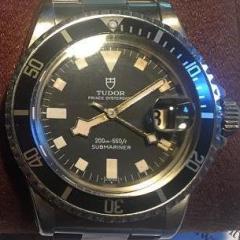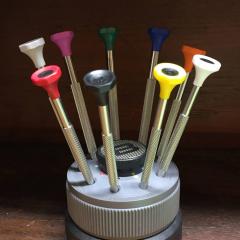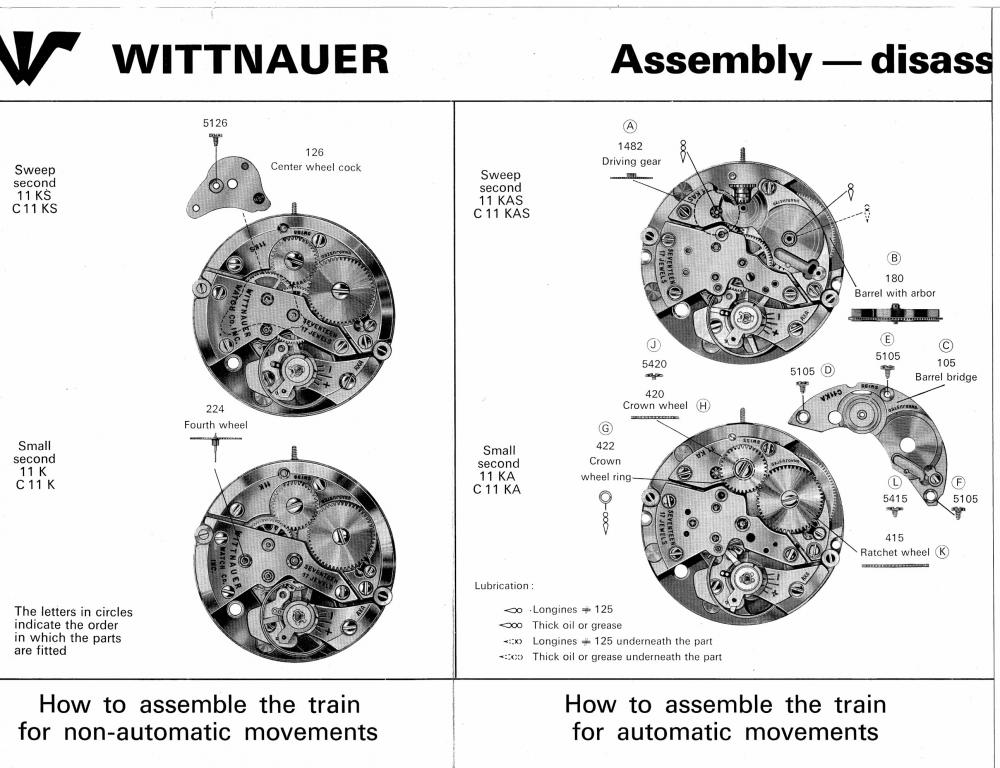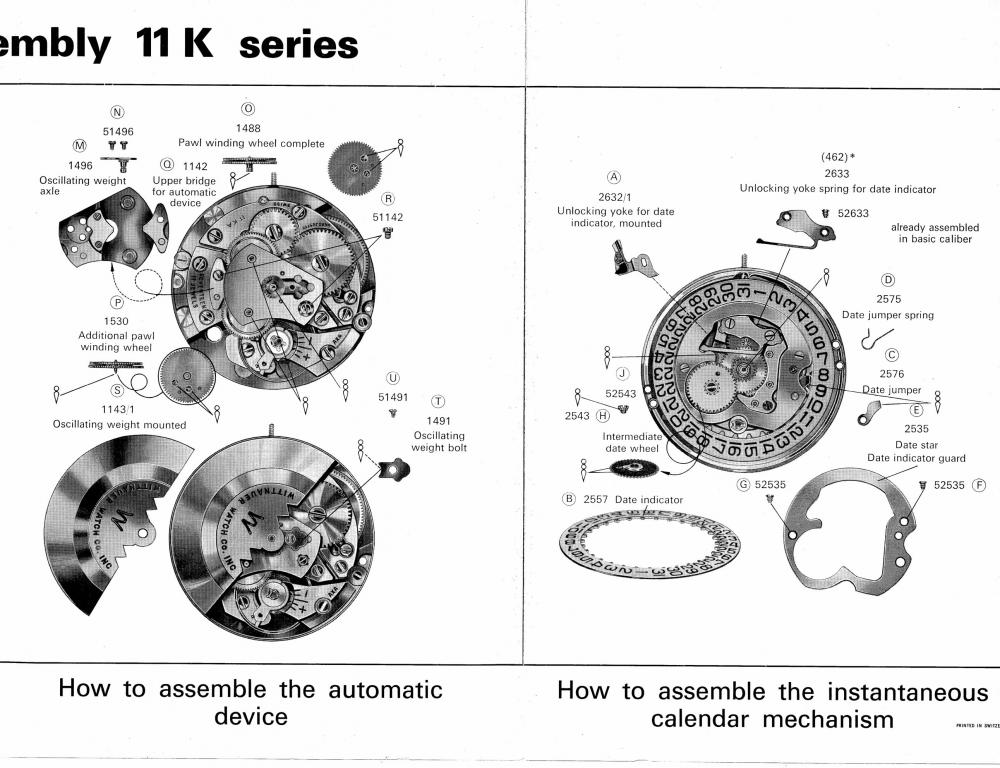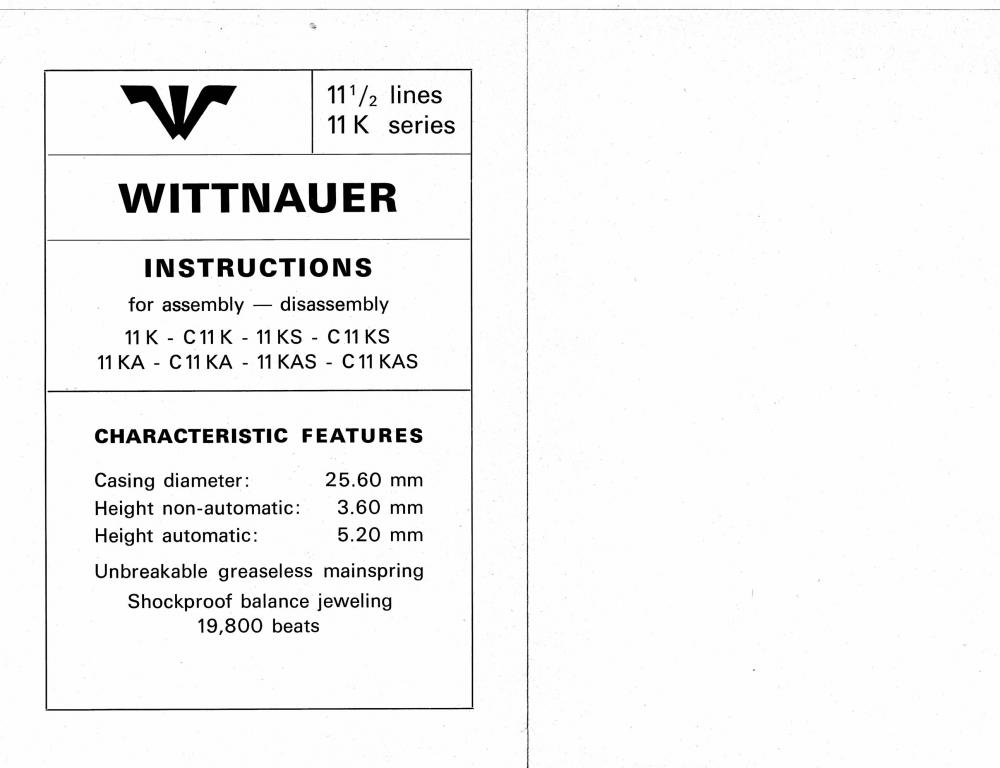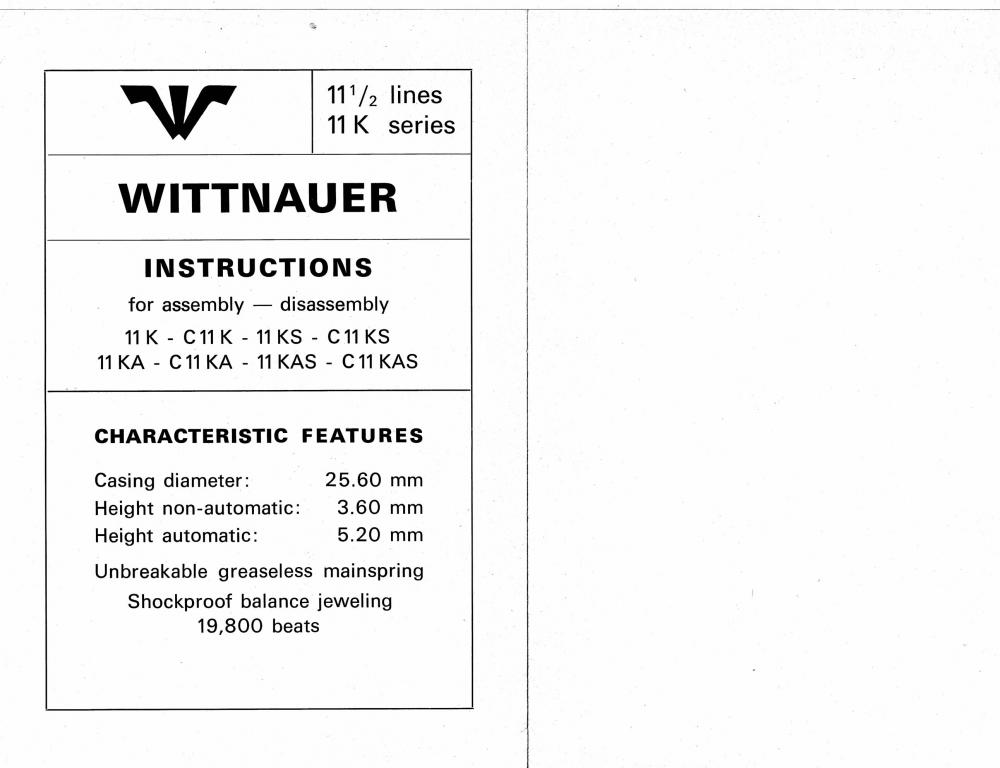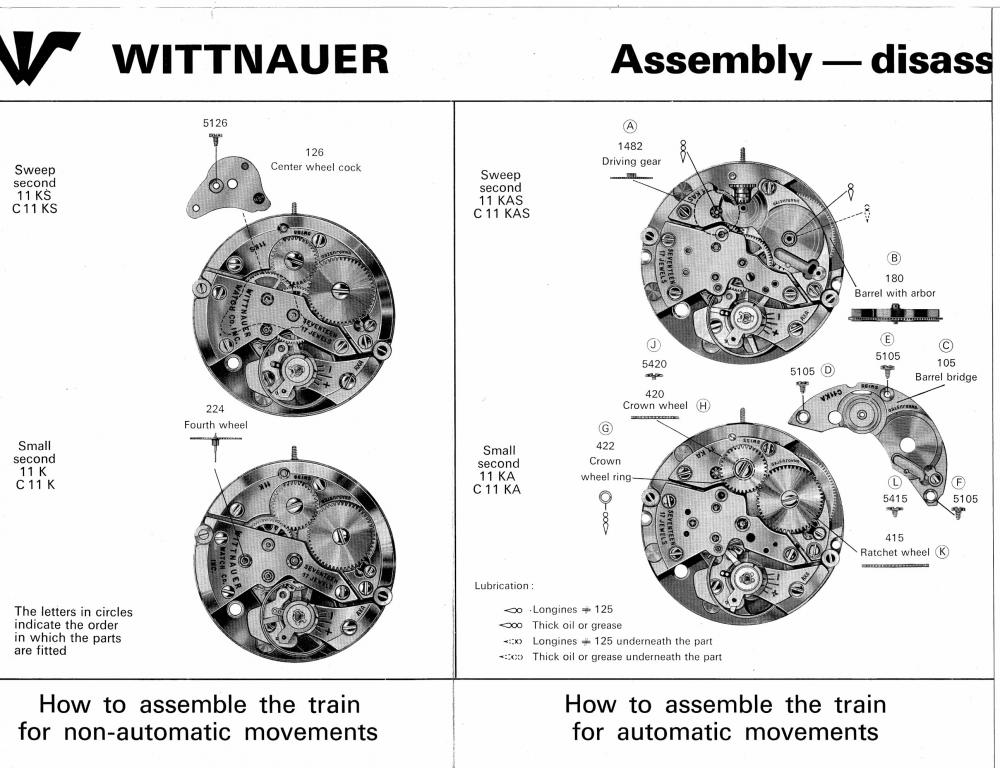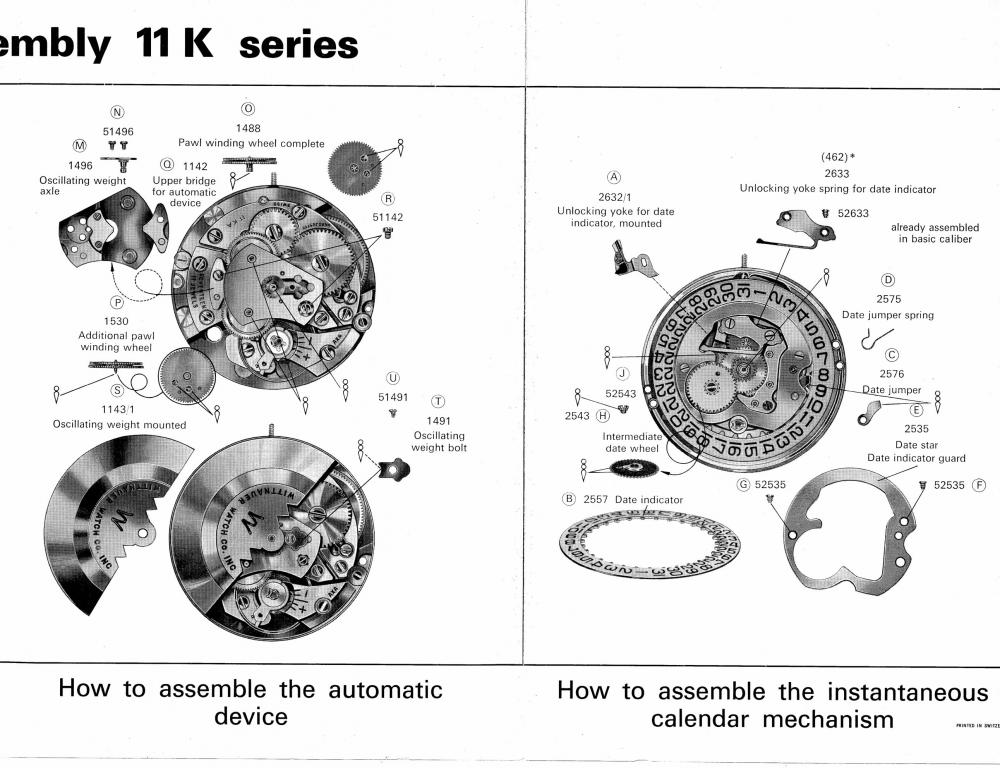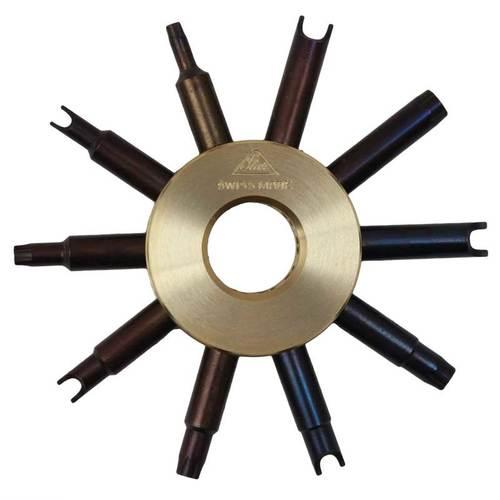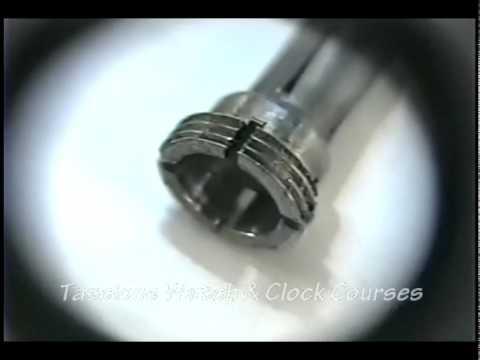Leaderboard
Popular Content
Showing content with the highest reputation on 08/30/18 in all areas
-
2 points
-
So today, I took a few minutes to make up a timing sheet for myself. It is based on (ok, ALMOST a blatant copy of) the Rolex service timing sheet. I liked the layout so I replicated it in excel. I didn't see another one around so I figured I'd post it up. I am attempting to attach it now- if it fails, PM me and I can email the file out. Let me know if you'd like to make changes, so we can implement improvements for everyone. You can of course adjust it to your liking since it's just excel. Timing Analysis.xlsx1 point
-
Here are the factory instructions for the Wittnauer 11 1/2 ligne 11K series. I hope people find it handy. I couldn't find anything about oiling the reversing wheels when I worked on my nephew's 11KAS, and here it was, just steps away from my bench. It's the only set of such instructions that I have, and was in a book I bought a few years back. Cheers.1 point
-
Allow me to point out that a none genuine H/S devalues the watch. Sorry you are wrong. A watch going and keeping time is more valuable then one that does not work. I also expect the H/spring would be the original. H/srings for these watches are not interchangeable none of the parts are. They might look the same to the eye but when it comes to fitting you notice it won't work.1 point
-
Thanks, if you are into Russian watches you need to take your misses on holiday to Rimini Italy, half way down the strip there is a roundabout on the side of the road there is a patch of grass where they hold an evening market I think it is on a Wednesday, there is a man on there and he must have about 300 Russian watches on his stand...1 point
-
I have a stash of hairsprings so replacing a HS is not to much of an issue for me anyway. However as oldhippy says if it was broken by the repairer then he should fix his breakage.1 point
-
You can download the Ronda catalogue off the cousins website a Ronda 256 is for a Tissot 12.5L calibre 28. https://www.cousinsuk.com/document/category/ronda-stems-by-ronda-number1 point
-
Try windingstems.com, you can search by the Ronda number. looks like this one will fit a number of Tissot movements.1 point
-
I've never seen a press fit one either. Apparently some of the smaller sleeves are hard to find now, I made a small one for a friend in the U.S. a couple of years ago and it was a pain to get it right. Way easier to make a normal winding stem. But there are stocks of these things out there, do some digging.1 point
-
1 point
-
Isn't that called a case tube or something ? Some are screw in while others are press fit. This might be easy to find, you just have to get the dimensions right. A watchmaker should sort this one out.1 point
-
1 point
-
the little split collet is what allows the stem (on a stem set p0cket watch) to snap in and out. I don't know of any one making them on a lathe. it would need to be tempered and designed to work with the stem shape. I have been lucky enough to find the pair on parts watches. good luck, let us know how the problem was solved. vin1 point
-
I also use the A-F brand hand setters similar to the ones shown in the eBay link. Bergeon makes them as well of course but these are an example of a tool where you don't need to spend a ton of money. It's just a bit of Delrin on the end of an aluminum tube... Get two sets and keep one stock and the other for modifying. Add a colored tape band to the modified ones* to tell them apart easily. One trick I use is to hold the hand with a piece of rodico near the tip of the hand, and place it that way. I only use the tool for pressing once the hand is on the proper pinion. There is no better way to destroy the seconds hand pinion than to press it when it's not in perfect position... It can also collapse the bore of the seconds hand and then you have a problem... I like the look and idea of those fancy hand setting stands, but you still need to set the hand correctly in the first place. I guess one advantage is it ensures the hand is pressed perpendicular to the main plate. *Note that I modified my hand setting tools, as I seem to end up doing to every tool, regardless of manufacturer. I used suitable drills to open up the small dimples in the ends of the tools for better clearance and additional depth. I like to just clear the canon pinion so that when I press the hour hand on, I am fully pressing the hand but also have a reference surface of the tool which will hit the top of the hour pinion, preventing me from pressing it too deep. With old printed dials, it's not a big deal, but more modern dials with applied indicies can be a big problem if you press the hands too far. I also use levers to remove hands, rather than the "presto" tools. Often these old hands are worth more than many people pay for entire watches, so the less you manipulate them, the better. I use Bergeon levers but I still polished them further myself to make them "perfect". They had a very nice mirror polish to them coming in but I wanted to soften a few edges to avoid marks. I think I have since chipped one and I needed to address that as well. They are VERY hard steel...1 point
-
1 point
-
Every other day I seem to need another tool.... Sent from my iPhone using Tapatalk1 point
-
Generally the stronger the magnification the shorter the focal length. Therefore you will need various lopes. I have found this article on the web which explains better than I could. PS I also use a microscope for the really close stuff such as hairsprings. BASIC TECHNICAL STUFF: MAGNIFICATION AND WORKING DISTANCE The following applies to simple lenses, including all jewellers loupes. The following does not apply to 'surgeons' magnifiers which are made of two small telescopes. THE 14 INCH RULE Some magnifiers are marked with the magnification, some are marked with the focal length (working distance) in inches. The focal length (working distance) is the ideal distance between the lens and the object, not too close (or the lens won't magnify) and not too far (or the image appears wavy). And if you hold the lens MUCH too far from the object, the image will appear upside down. Most people don't understand 'focal length' and so when they see a '3' (for some reason eyeglasses are often marked like this) they think it means "3X magnification" when it really means "three inch focal length". Matters are made worse by the fact that many manufacturers are 'approximate' in their calculations, you can measure the working distance of a 1" magnifier and find it is nearer to 2". So what is the relationship between focal length (working distance) and magnification? Here is the way I used to calculate it. If you take a 'normal' working distance for reading to be 14", then a 7" magnifier brings you twice as close = 2X magnification. This '14 inch rule" is what I used in my catalogue to calculate magnification up until 2011, and the arithmetic works out like this: 1.5 inch = 9.3X magnification 2 inch = 7X magnification 2½ inch = 5.5X magnification 3 inch = 4.5X magnification 3½ inch = 4X magnification 4 inch = 3.5X magnification 5 inch = 2.8X magnification 6 inch = 2.3X magnification 7 inch = 2X magnification 8 inch = 1.8X magnification 9 inch = 1.5X magnification This '14 inch rule" is the way I used to calculate it; it is also the way our manufacturer of watchmakers eyeglasses calculates it, the numbers convert nicely from inches into more-or-less whole numbers for 'magnification', as you see from the chart above. THE 10 INCH RULE Then I discovered that according to the almighty Wikipedia the 'normal' working distance for a lens is 10 inches. This is rather neat because (as you will see if you read the extra-technical stuff below) 10 inches is about 25cm, and 25cm X4 = 1 meter (near enough), and physicists use 1 meter as the definition of 'standard' focal length (not very practicable as a 'working distance')...but don't worry about that, all you need to know is - the way I calculate magnification now falls in line with the 'official' method you find online, like this: 1 inch = 10X magnification 2 inch = 5X magnification 2½ inch = 4X magnification 3 inch = 3.4X magnification 3½ inch = 2.8X magnification 4 inch = 2.5X magnification 5 inch = 2X magnification 6 inch = 1.7X magnification 7 inch = 1.5X magnification 8 inch = 1.3X magnification 9 inch = 1.1X magnification These numbers aren't as good as the old "14 inch rule". For instance, both a 3½ inch and a 4 inch lens have a magnification of about 3X. And both a 5 inch and a 6 inch lens both have a magnification of about 2X. And I get customers who think I'm being evasive when I describe two eyeglasses as being, "about the same magnification". If you would like to try out different focal lengths and magnifications to see how they convert (using this "10 inch rule"), go to my conversion program, click here (it's an Excel file, so you might have to select OPEN). WHAT DO OPTICIANS AND SCIENTISTS SAY? This entire system of magnification being "how many times bigger than normal" (or "X magnification") mystifies opticians. What is 'normal'? It varies from person to person. For an optician, a lens has a focal length - a number that can be calculated, not a 'magnification' relative to normal'. If you really want a definition of 'normal' you should use the standard distance (focal length) used by physicists: 1 meter. But by this definition you need awfully long arms to hold a 'normal' lens in one hand and a book one meter away in the other hand. Also, the human eye often requires more than 'just a bit of help with magnification'. That is why you go to an optician - because he has spent years studying optics rather than reading an entry in Wikipedia. I am not an optician and my knowledge of the maths of optics is shamefully poor. I will, however, attempt to guide you through the mysteries of magnification in the following few paragraphs. They are a bit technical, so you may prefer to skip them and go straight to 'CONCLUSION'.. ADVANCED TECHNICAL STUFF The following calculations apply to simple lenses, including all jewellers loupes. The following does not apply to 'surgeons' magnifiers, which are made of two small telescopes, or to microscopes. FOCAL LENGTH, DIOPTRES AND MAGNIFICATION "Working distance" is the same as focal length. The focal length is the distance you hold the lens from the object that gives the most magnification and the clearest image; it is also the point at which a distant bright object (e.g. the sun) makes the smallest image (e.g. to make a fire using the sun); it is also the distance at which you can project a bright scene onto a surface (stand in a dimly-lit hallway and project the image of a bright window onto the wall). Try it with any magnifier, the distance from the lens to the object will be the same with each of the above experiments, this is the focal length of the lens. In practical terms we can also describe this as, "the [ideal] working distance." 'Dioptre' is the reciprocal of the focal length. The dioptre is the measurement used by opticians and lens-makers, it is more reliable than defining magnification as "how much larger than normal an item appears". This is because "normal" varies from person to person (there is no rule that says you have to hold a book ten inches from your eyes!). 'Dioptre' is the reciprocal of the focal length. To write this as a formula, call the magnification M (if you prefer you may say P for power rather than M for magnification...but let's keep things simple) and the focal length f (in meters not inches) which gives: M = 1 / f. But this 'magnification' is based on the physicist's 'standard' focal length of 1 meter. If you assume 'normal' working distance for a human holding a magnifier to be a quarter of a meter (about ten inches*) then you must divide by four. The formula for converting dioptre to magnification is therefore M = D / 4. * this is not because there is anything special about 10 inches, merely that it works nicely as a number, because 10 inches is almost 250mm = 0.25m, which is why we divide by four. This is one of two accepted formulae for calculating magnification. The above formula works beautifully for small powerful magnifiers such as jewellers loupes and small readers. For instance, for a magnifier with a focal length of 30mm: 1 / 0.03m / 4 = X8.33 magnification. But this formula is based on two assumptions: a) that the object is held at the 'ideal' distance from the lens (its focal length) to give maximum magnification that the lens is held very close to your eye so that your eyes are focusing into the distance (at infinity). This doesn't work for large lenses with long focal lenses. For instance, if we apply the formula to a large reading magnifier with a focal length of 500mm we get 1 / 0.5m / 4 = X0.5 magnification. Oh dear, that can't be right, it looks as if it reduces rather than magnifies. In a sense, this is true, if you place an object 500mm from the lens and hold the lens against your eye, it won't magnify at all. What you must do is move the object closer than 500mm from the magnifier (the magnification will be less) then move your eye away from the magnifier. Your eyes are no longer looking into the distance (infinity) but are focusing closer. To allow for this there is another accepted formula for calculating magnification: D / 4 + 1. Applying this to our magnifier with a 500mm focal length, we now get 1 / 0.5m / 4 + 1 = magnification X1.5, which is more plausible. All of these figures for 'magnification' are approximate, and there are many reasons for this. Firstly, it depends which formula you use (see above). Secondly, if the result looks clumsy (e.g. a magnification of X8.333) the supplier will round it up or down. Thirdly, how much closer than your 'normal' reading distance an object appears depends on what is 'normal' for you. Fourthly, if you use the "ten inch rule" (see explanation above, and also my magnification calculator) instead of the formula, you get slightly different figures because ten inches isn't exactly 250mm. Fifthly, even when you go to the trouble to measure the focal length and calculate the magnification, you will often find that what is printed on a magnifier is simply wrong. If you think this is all a little confusing, it is. In fact, it's very confusing. For instance, if you place the object too close to the lens (less than its focal distance) the magnification will be less, and if you hold your eye away from the lens, the magnification will appear to be more. One nationally-known company specialising in magnifiers consistently used the first formula, above (D / 4). As a result, most of their magnifications were listed as being less than one, indicating that they made everything appear smaller rather than larger. Then they re-printed their brochure, listing magnifications consistent with the second formula, D / 4 +1. The famous optical company Zeiss produce a standard 10X jewellers loupe with two lenses, they fold out and can be used individually or on top of each other (the two magnifications simply add together). At one time they quoted the magnification of the two lenses as 6.66X + 3.33X = near enough 10X when used together; then it became 6X + 4X = 10X; now they label it 3X + 6X = 9X. I don't believe they have been changing the lenses each time, the slight variations are due to the way they calculate 'magnification' then round the figures up or down. IF YOU WEAR SPECTACLES If you wear spectacles, should you keep them on whilst using a magnifier? When using a large magnifier (e.g. for reading) the answer is: yes. I assume, here, that you need a magnifier because the print / map / mark is exceptionally small and you need that extra help in addition to your spectacles. When using a small magnifier (e.g. a jeweller's loupe or watchmaker's eyeglass): do whichever is the most comfortable, but you must keep the magnifier as close to your eye as possible. The only time you may wish to think about whether to keep your spectacles on or take them off is if you are wearing a magnifier over your head (a binocular headband magnifier), they can be used with or without spectacles, as follows: If you are short-sighted (you have difficulty in seeing far objects, your spectacle lens prescription has a power beginning 'minus' ) you will notice that when using the magnifier without your spectacles the working distance is less than marked on the magnifier. If you are very short-sighted you will also notice that if you don't use a magnifier you can focus on very close objects - you have magnifying eyes for close objects (the only drawback being that you can't focus on far objects). The consequence is that with a binocular magnifier you may choose between two magnifications: one (weaker / further away) when you wear the magnifier over your distance spectacles and one (closer / stronger) when you wear the magnifier without spectacles, whichever you find the most comfortable. If you are long-sighted (you have difficulty in seeing near objects, your spectacle lens prescription has a power beginning "plus") you will notice that when using the magnifier without your spectacles, the working distance is more than stated on the magnifier. If you are very long-sighted you will also notice that a low-power magnifier doesn't actually magnify at all, it merely brings close objects into focus at a 'normal' viewing (e.g. reading) distance, which is exactly what your reading spectacles do: they are low-power magnifiers. The consequence is that with a binocular magnifier you may choose between two magnifications: one (stronger / closer) when you wear the magnifier over your spectacles and one (weaker / further away) when you wear the magnifier without spectacles, whichever you find the most comfortable.1 point



